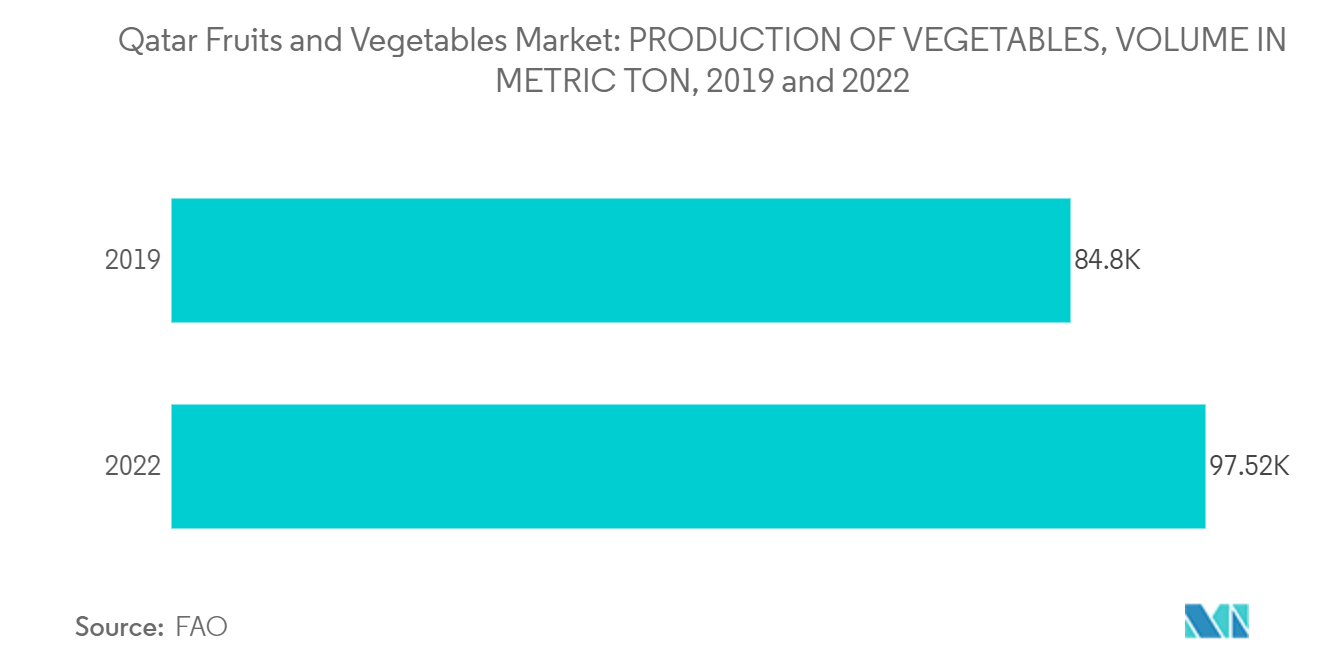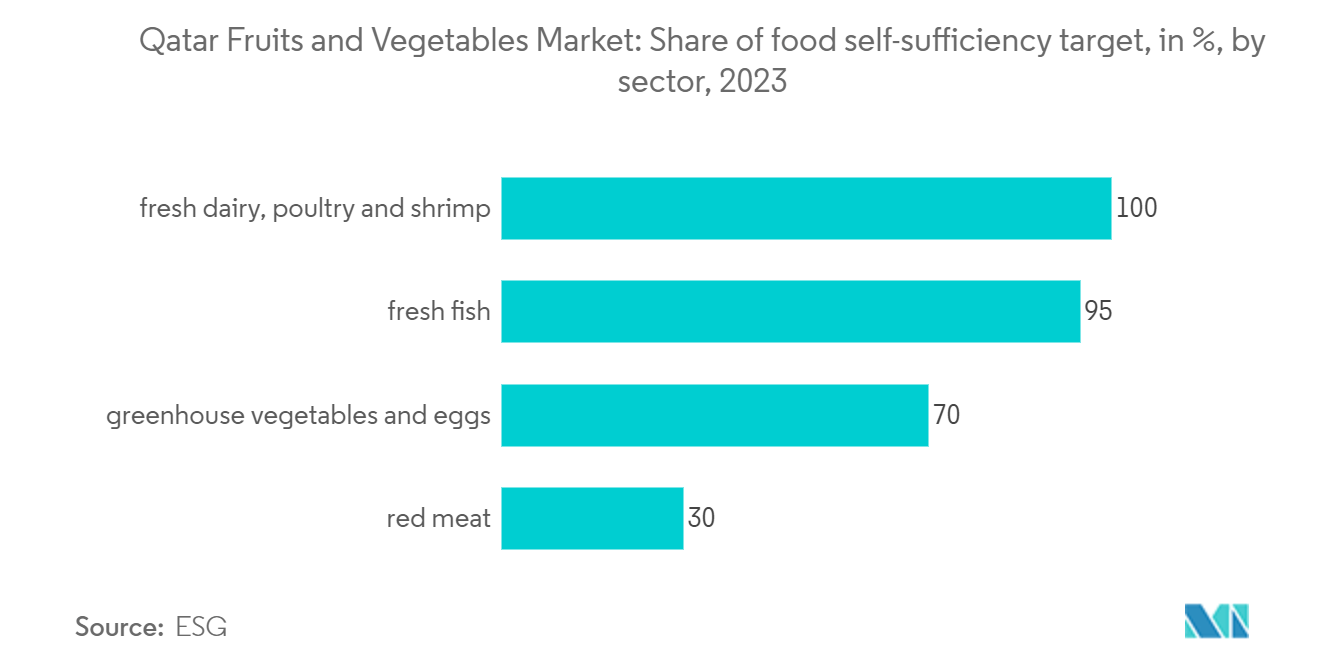Qatar Fruit and Vegetable Market Size

| Study Period | 2019 - 2029 |
| Base Year For Estimation | 2023 |
| Forecast Data Period | 2024 - 2029 |
| Market Size (2024) | USD 685.23 Million |
| Market Size (2029) | USD 837.21 Million |
| CAGR (2024 - 2029) | 4.10 % |
Major Players*Disclaimer: Major Players sorted in no particular order |
Qatar Fruit and Vegetable Market Analysis
The Qatar Fruits And Vegetables Market size is estimated at USD 685.23 million in 2024, and is expected to reach USD 837.21 million by 2029, growing at a CAGR of 4.10% during the forecast period (2024-2029).
The increase in the adoption of advanced farming technologies and conducive government policies supporting domestic fruit and vegetable production are some factors driving the market growth in the country. Over the past few years, Qatar has imported fruits and vegetables from countries such as India, the United States, Iraq, China, Pakistan, and the Netherlands to meet domestic demand. To overcome this, the country aims to achieve agricultural self-sufficiency by encouraging farmers to adopt advanced techniques that support local production and increase self-reliance.
Many companies are venturing into domestic fruits and vegetable cultivation by incorporating advanced farming technologies to make them available to consumers year-round and move toward less dependency on trade imports. For instance, VFarms, a member of Qatar Science & Technology Park (QSTP), showcased its new high-tech indoor cultivation facilities promoting eco-friendly farming in Qatar at Expo 2023 Doha. The facility enables farmers to grow crops without external water supply and harvest water from the atmosphere using solar energy. This facility helps in the year-round cultivation of crops, mainly vegetables, berries, and others, irrespective of seasonal and climatic variations.
Qatar Fruit and Vegetable Market Trends
Increase in Adoption of High Technology Farming Practices
The climate in Qatar is characterized by low rainfall and high temperatures. Despite these challenges, the country has made tremendous efforts by adopting sustainable and smart agriculture, such as hydroponics, smart irrigation, and aquaponics, to improve the optimum utilization of arable land and the quality of fruits and vegetables. For instance, in 2022, the Institute of Urban Agriculture (IUA) of the Chinese Academy of Agricultural Sciences (CAAS) improved the pattern of vegetable production in Qatar by introducing a new combination of hydroponics and solid active fiber soil technique or the Leitu technique. The technique replaces soil with an ecological material mainly made from straw, cotton stalks, and other agricultural and forestry wastes. It also provides growing conditions for more varieties of vegetables, including leafy greens, eggplants, tomatoes, and cucumbers.

Increased Focus on Sustainability and Organic Food Products
The trend of local produce products is gaining traction among Qatar consumers. Consumers perceive local produce as of better quality and are aware of the low carbon footprint of such products, including fruits and vegetables, compared to imported products. Moreover, the rising health-conscious population in Qatar is moving towards higher quality and long-lasting juices. Consumers also want to know the farm-to-shop journey with the most diminutive carbon footprint. Therefore, Qatari companies diversifying into juices focus on adopting various sustainable practices to retain their consumer base. Further, the government created a conducive environment for farming by using sustainable agriculture practices to overcome the challenges of the blockade against Qatar by its neighboring countries, such as Saudi Arabia, the United Arab Emirates, Bahrain, and Egypt. As a result of such government initiatives, vegetable production grew during the study period and is anticipated to further boost during the forecast period. For instance, according to FAO, the total vegetable production in Qatar rose from 84,795 metric tons in 2019 to 97,519 metric tons in 2022.

Qatar Fruit and Vegetable Market Report - Table of Contents
1. INTRODUCTION
- 1.1 Study Assumptions and Market definition
- 1.2 Scope of the Study
2. RESEARCH METHODOLOGY
3. EXECUTIVE SUMMARY
4. MARKET DYNAMICS
- 4.1 Market Overview
-
4.2 Market Drivers
- 4.2.1 Increasing Adoption of High Technology Farming Practices
- 4.2.2 Government Initiatives to Increase Local Production
-
4.3 Market Restraints
- 4.3.1 Limited Resource Availability and Unfavorable Climatic Conditions
- 4.3.2 Reliance on Imports for Domestic Supply
5. MARKET SEGMENTATION (Production Analysis by Volume, Consumption Analysis by Volume and Value, Import Analysis by Volume and Value, and Export Analysis by Volume and Value)
- 5.1 Vegetables
- 5.2 Fruits
6. Prices Trend Analysis
- 6.1 Tomatoes
- 6.2 Spinach
- 6.3 Pumpkin
- 6.4 Cabbages
- 6.5 Dates
- 6.6 Watermelon
- 6.7 Eggplant
- 6.8 Cucumber
7. Regional Analysis
- 7.1 Pestle Analysis
- 7.2 Value Chain Analysis
- 7.3 Government Policies and Regulations
8. Competitive Analysis
- 8.1 Distribution Network and Retail Analysis
-
8.2 List of Key Retail Chains
- 8.2.1 Lulu Hyper Market
- 8.2.2 Al Meera Consumer Goods Company
- 8.2.3 Carrefour group
- 8.2.4 Arab Qatari Agricultural Production Company
- 8.2.5 AL SHAHABI TRADING CO.
- 8.2.6 World Fruit Centre W.L.L
- 8.2.7 Agrico
- 8.2.8 SANWARA FRUITS & VEGETABLES W.L.L.
9. MARKET OPPORTUNITIES AND FUTURE TRENDS
** Subject To AvailablityQatar Fruit and Vegetable Industry Segmentation
Fruits and vegetables are high in vitamins, minerals, and phytochemicals. The Qatar fruits and vegetables market is segmented by type into fruits and vegetables. The report provides insights into the production (volume), consumption (volume and value), import (volume and value), and export (volume and value) of the fruits and vegetables market in Qatar. The report also provides a price trend analysis. The report offers market size and forecast in terms of value in USD and volume in metric ton for the segments mentioned above.
Qatar Fruit and Vegetable Market Research FAQs
How big is the Qatar Fruits And Vegetables Market?
The Qatar Fruits And Vegetables Market size is expected to reach USD 685.23 million in 2024 and grow at a CAGR of 4.10% to reach USD 837.21 million by 2029.
What is the current Qatar Fruits And Vegetables Market size?
In 2024, the Qatar Fruits And Vegetables Market size is expected to reach USD 685.23 million.
What years does this Qatar Fruits And Vegetables Market cover, and what was the market size in 2023?
In 2023, the Qatar Fruits And Vegetables Market size was estimated at USD 657.14 million. The report covers the Qatar Fruits And Vegetables Market historical market size for years: 2019, 2020, 2021, 2022 and 2023. The report also forecasts the Qatar Fruits And Vegetables Market size for years: 2024, 2025, 2026, 2027, 2028 and 2029.
Qatar Fruit and Vegetable Industry Report
The Qatar fruit and vegetable market is poised for significant growth, driven by various industry trends and factors. The market research indicates a positive market outlook, with substantial market data supporting the forecast. The industry research highlights the market segmentation, providing a detailed market overview and market review.
The industry analysis reveals that the market leaders are focusing on expanding their market share through strategic initiatives. The market report provides a comprehensive market forecast, predicting robust market growth in the coming years. The industry size is expected to increase, supported by favorable market conditions and consumer demand.
The report example includes valuable industry information, offering insights into industry sales and market value. The industry reports and industry statistics are crucial for understanding the market dynamics and making informed decisions. The market predictions suggest a promising future, with the market segmentation playing a key role in targeting specific consumer segments.
The market research emphasizes the importance of understanding the market trends and industry outlook to stay competitive. The market data and market forecast are essential tools for businesses to plan their strategies effectively. The industry reports and industry research provide a solid foundation for analyzing the market and identifying growth opportunities.
The report pdf offers a detailed analysis of the market, including industry trends and market value. The industry information is vital for businesses looking to expand their presence in the Qatar fruit and vegetable market. The industry outlook and market predictions highlight the potential for growth and the factors driving the market.
In conclusion, the Qatar fruit and vegetable market is set for substantial growth, supported by comprehensive industry analysis and market research. The market data and industry statistics provide valuable insights, while the market forecast and market predictions offer a clear view of the future. Businesses can leverage this information to enhance their market share and capitalize on the growth opportunities in the industry.



